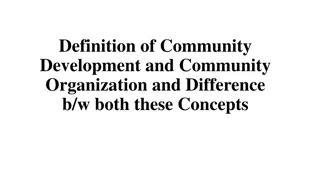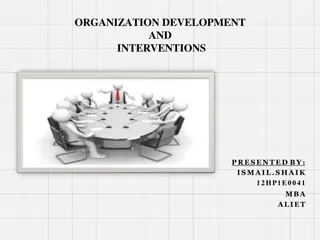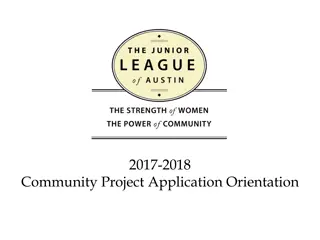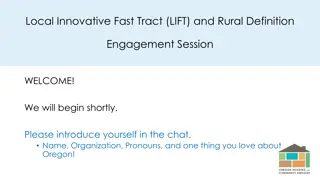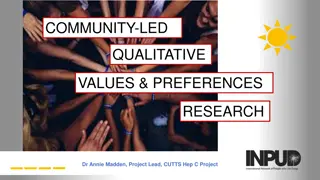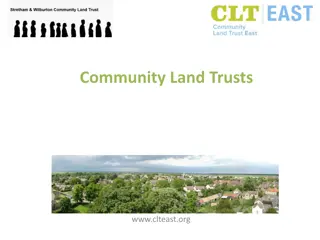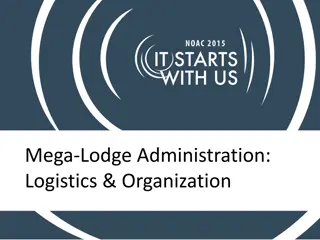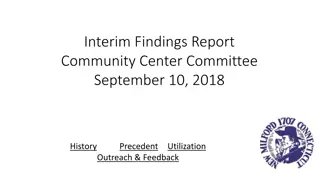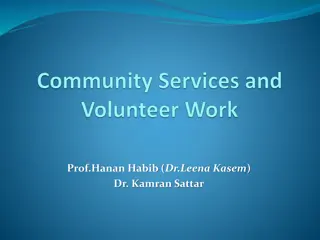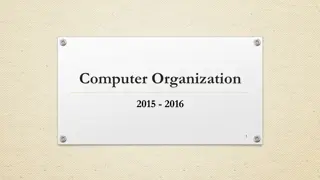Understanding Community Organization: History, Definition, and Types
Community organization is a vital aspect of social work focusing on meeting the needs of urban communities and promoting citizen participation. The concept has evolved in the United States to create effective adjustments between community resources and welfare needs. Various types of community organizations exist, including self-help, partnership, and co-production organizations, each serving unique purposes in addressing shared problems and fostering community empowerment.
Download Presentation

Please find below an Image/Link to download the presentation.
The content on the website is provided AS IS for your information and personal use only. It may not be sold, licensed, or shared on other websites without obtaining consent from the author. Download presentation by click this link. If you encounter any issues during the download, it is possible that the publisher has removed the file from their server.
E N D
Presentation Transcript
Community Organization History The concept of community organization was developed in the United States from the experience of evolving institutions to meet people needs in urban areas and to promote citizen participation. It came to be associated with the urban environment of North American towns and cities. The term is used in Social Work literature as the traditional third setting of Social Work, the others being case work and group work. organizations and
Definition of Community Organization 1. Khalid Mohammad (1992) opines that community organization refers to the adjustment between the needs and resources of a community. As a process, community organization implies those welfare measures which are undertaken by the members of a community in accordance to their needs and resources. 2. Mildred Barry (1992) says that community organization in Social Work is the process of creating and maintaining a progressively more effective adjustment between community resources and community welfare needs. This adjustment is achieved through the help of the professional worker and the participation of individuals and groups in the community. 3. Rubin Herbert and Rubin Irene (1986) suggests that community organization is brining people together to combat shared problems. Community organizing is a political process to determine who decides what about which issues, and it increases the power of those who currently have little say about decisions that affect their lives.
Types of Community Organization There are five types of community organizations i.e. self-help, partnership, co-production, pressure and protest organizations. 1. Self-help Organization Self-help organizations are groups of people who provide mutual support and assistance to each other for the purpose to meet a need or to pursue collective goals. They offer a vehicle for people with a common problem to gain support and recognition, obtain information on, advocate on behalf of, address issues associated with, and take control of the circumstances that bring about, perpetuate, and provide solutions to their shared problems. Self-help groups may be small informal groups, confined to interactive support for their members. In self-help organizations, the members identify and prioritize their problems and find out solution to the problems with minimal help or interaction from outside agencies.
2. Partnership Organization Partnership organizations are developed by community members who themselves define which problems to work on, but often rely upon outside financial assistance. organizations, the people unite with each other to identify and prioritize their needs and get resources from other agencies for the purpose to develop their community. In partnership
3. Co-production Organization Co-production means that community organizations undertake activities with government which in the past were carried out only by government agencies. These organizations are staffed wholly or in part by organizational members. Usually some decision- making responsibility devolves to community members. Examples of co-production organizations are; PTC (parents teacher council), SMC (school management committee) management committee) etc. and HMC (health
4. Pressure Organization . . . . Pressure organization is a group of people who choose their own issues but try to work within the conventional rules of government to persuade politicians and bureaucrats to change policies. 5. Protest Organization Protest organizations usually want to bring a change in the economic or political system and often work outside of the conventional rules. They adopt all kinds of tactics including humor and disruption, to force their opponents inside and outside government to satisfy community protesters who engage in marches, sit-ins and demonstrations exemplify more issue- oriented protest groups. . . . / . . . . . . demands. Civil rights
How to form a community-based organization at a street (muhalla) level? Primarily, following steps are needed to form a community-based organization at a street level. Step-1. Identification and selection of the area Step-2. Identification of contact persons and activists (CRPs-Community Resource Persons) Step-3. Problems need assessment (community profiling) Step-4. Identification of the entry point/common interests of the people Step-5. Series of dialogues and completion of baseline data Step-6. Organization of the community people (community based organization-CBO) Step-7. Developing objectives of the CBO through community members Step-8. Election of office bearers or representatives of the community based organization Step-9. Opening a joint bank account with the name of CBO Step-10. Orientation of CBO members regarding their roles and responsibilities and necessary record keeping Step-11. Identification and prioritization of needs of the community Step-12. Preparation of community action plan Step-13. Facilitation of the people for developing linkages with other governmental and non-governmental support services organizations Step-14. Capacity building of the members of the community based organization





